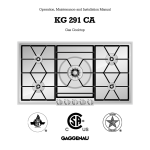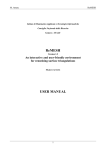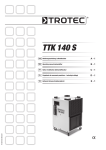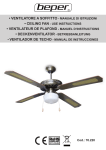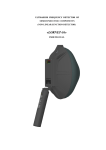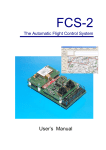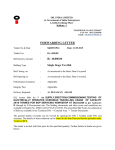Download Gaggenau KG 291 User's Manual
Transcript
Operation, Maintenance and Installation Manual KG 291 Gas Cooker KG 291 1. Important Notes For Your Safety Operating for the First Time About Use 2. Features Features of the Appliance Control Knob Burner Parts 3. Operating Principle 4. Operation 5. Settings Table 6. Cookware Recommendations 7. Wok Cookware Recommendations 8. Cleaning and Care 9. Maintenance 10. Trouble shooting 11. Technical Data / Nozzle Table 12. Installation Instructions Important Notes Gas Connection / Electrical Connection Nozzle Replacement Installing the Appliance Page 3-4 Page 3 Page 3 Page 4 Page 5 Page 5 Page 5 Page 5 Page 6 Page 7-8 Page 9 Page 10 Page 11 Page 12-14 Page 15 Page 16 Page 17-19 Page 20-26 Page 20-21 Page 22 Page 23-25 Page 26 1 2 1. Important Notes For Your Safety Operating for the First Time You must not operate the appliance if it is damaged. Remove the packaging from the appliance and dispose of it according to local regulations. Be careful to remove all accessories from the packaging. Keep packaging elements and plastic bags away from children. When connecting electrical appliances in the proximity of the appliance, make sure that connecting leads do not come into contact with hot cooking surfaces! As the user, you yourself are responsible for maintenance and proper use in the household. Check the appliance for transport damage before installing it. Do not operate the appliance without pots and pans placed on it. Make sure that all the burner parts are correctly fitted. The appliance must be installed and connected by an authorised specialist before operation. The installation must conform with all current regulations of the gas supply companies and the regional construction regulations. Caution: The appliance heats up during operation. Keep children away. Turn all control knobs to the OFF position before connecting the appliance to the power supply. Do not clean the appliance with a steam cleaning apparatus or with water pressure - risk of shortcircuits! The serial number of the appliance can be found on the quality control slip which is included with these instructions. This quality control slip should be kept, for guarantee reasons, together with your operating and assembly instructions. Only ever operate the appliance under supervision. Isolate the appliance from the mains during every maintenance operation. To do this, remove the mains plug or switch off the corresponding household fuse. Close the gas supply. Repairs must be carried out by authorised specialists, thus ensuring electrical safety. No warranty claims can be lodged for any damage resulting from failure to observe these instructions. Read through these instructions attentively before operating your appliance for the first time. Thoroughly clean the appliance and accessories before using them for the first time. This will eliminate any 'newness' smells and soiling (see chapter “Cleaning and care”). Observe caution with oils and fats. They may overheat and burn easily. Foodstuffs that are prepared in fat and oil must only be prepared under constant supervision! Technical modifications reserved. 3 About Use The appliance is intended solely for use in the household and must not be put to any other uses. Use the appliance to prepare meals only. It must not be used to heat up the room in which it is installed. Use of a gas cooker generates heat and humidity in the room where it is installed. This is why attention must be paid to good kitchen ventilation. The natural ventilation openings must be kept unobstructed. Prolonged use of the appliance with several or all rings may call for additional ventilation such as opening a window or a door, or stronger air extraction by an extractor hood. To guarantee good combustion, the room in which the appliance is installed must have a minimum volume of 35 m3 and must possess a door that opens outdoors or a window that can be opened. Keep the ventilation openings at the back of the appliance free at all times. Only ever use the burners after placing pots and pans on them. Do not heat up any empty pots or pans. It is not permitted to use roasting pans, frying pans or grill stones heated simultaneously by several burners because the resulting heat build-up may damage the appliance. 4 Pots with a diameter of less than 90 mm or more than 280 mm / 320 mm for the large (WOK) burner should not be used. When using large pots, pay attention to keeping to a minimum distance of 50 mm between the cooking vessel and combustible surroundings. A minimum distance of 50 mm must be observed between the control knob / control panel and the pot or pan. The pot or pan should not touch the control panel. Switch the burners to the low setting whenever you remove pots or pans briefly. In this way, you reduce the risk of burns when working next to naked flames; you also save gas and reduce pollution. Whenever the gas hob is fitted under an extractor hood, always cover the rings with pots or pans. Otherwise, parts of the extractor hood may become damaged by the extreme heat development or grease residues in the filter may ignite. Ensure an adequate supply of air when using an extractor hood operating in the extraction mode The appliance cannot be used during a power failure. In the event of malfunctions, please inform your specialist dealer or your nearest Gaggenau aftersales service. 2. Features Features of the Appliance 1 Pot grids (3 parts, the left and right part are identical) 2 Large (Wok) burner 5 kW 3 Large burner 4 kW 4 Normal burner 2 kW 5 Ventilation openings Control Knob 6 Symbol for corresponding cooking position 7 Indicator light 8 Flame setting: 0 OFF High setting of outer and inner flame ring Low setting of outer flame ring High setting of inner flame ring Burner Parts 9 Outer flame ring off High setting of inner flame ring Outer flame ring off Low setting of inner flame ring 10 9 Burner head cover 11 10 Burner ring 11 Burner head 12 12 Electrode for automatic ignition, flame detection and flame control 5 3. Operating Principle The gas hob features two normal burners, two large burners and a Wok burner. The appliance features one-hand operation, flame detection and automatic re-ignition. The ignition is activated when the control knob is turned. Should the flame go out during operation, the appliance will automatically re-ignite the burner. During a disturbance, the appliance will cut off the gas supply as a safety measure, to prevent unburned gas escaping. The flame setting is infinitely variable between high and low. The total rated thermal load amounts to: 17.0 kW referred to Hs* (gross calorific value) 15.3 kW referred to Hi (calorific value) The specified rated load is defined by installation of the fixed nozzles. The gas hob is converted to a different gas type by nozzle replacement (full and low-burning nozzles) (see nozzle table on page 17-19). 6 4. Operation Only light a burner if all burner parts are dry, and assembled correctly. Otherwise, malfunctions may occur or the appliance may switch off. Switching on • Place a suitable pot or a pan on the corresponding cooking position. • Press down the control knob for the corresponding cooking position and turn it to the required position between the and symbols. The burner ignites automatically. • When using large pots or pans you should ignite the burner in the low position. • Every time the gas hob is switched on, the electronics run an auto test. All electrodes fire and the required burner ignites after a few seconds. When switching on further burners, only the corresponding electrode fires. • When being switched on, a short sound may be heard when the electronic of the gas hob opens the gas supply valve. This is a normal condition. The flame size can be set continuously between full and low by slowly turning the control knob. Indicator light The indicator light next to the control knob comes on, if the burner is switched on and the flame burns correctly. Should the flame go out during operation (e.g. because of a draught), the appliance will automatically re-ignite the burner. Should the re-ignition be unsuccessful (e.g. burner is soiled by spilled over food or liquid), all burners are switched off, the indicator lights of the burners that were switched on flash. Turn all control knobs to the OFF position. The flashing indicator lights will go out except for the affected burner. This indicator will continue to flash for a few seconds. After the 7 appliance has cooled down sufficiently, check this burner to see if all the burner parts have been assembled correctly. Check if the burner or the electrode has been soiled (see trouble shooting guide on page 16). Note: if a malfunction occurs on one burner, you can continue using the remaining burners, however, you must turn all control knobs to the off-position first, before recommencing. Please note when switching on the cold appliance on the HIGH setting: depending on the gas type and pressure, it is possible that the electrode continues to fire, although there is a flame visible, and then switches off. Turn all control knobs to the OFF position. Then turn the control knob for the required cooking position to any setting except the high position and leave to warm up for 30 to 60 seconds. Then you can continue to use your appliance as usual. Switching off Fully turn the control knob to the OFF position. The electronics of the appliance switch the gas supply off, if all control knobs are in the off position. 8 5. Settings Table Cooking level Cooking method Examples High Boiling Searing Heating Boiling Blanching Water Meat Fat, liquids Soup, sauce Vegetables Roasting Browning Roasting Baking Boiling in open pot Simmering in open pot Meat, fish, potatoes Flour, onions Almonds, breadcrumbs Pancakes, egg dishes Liquids Dumplings, sausages, soup garnish, meat stock, poached eggs Simmering Boiling with closed lid Steaming Stewing Braising Sweet sauces Pasta, soup, sauces Vegetables, potatoes, fish Vegetables, fruit, fish Goulash, rolled beef steaks, roasts, vegetables Thawing Slow cooking Reheating Frozen foods Rice, pulses Soup, casserole, vegetables in a sauce From to From to Low Switch to the high setting in order to reach the required temperature quickly. Then switch back to a lower setting. The output of the inner flame ring is the same on the normal, as well as the large burners. The values given above must be looked upon as recommended values. The heat required depends not only on the type and condition of the food, but also the size and contents of the pot. Due to the high performance of the cooktop, fat and oil will heat up quickly. Never leave the cooktop unattended, fat can ignite, food can burn. Preferably use the rear cooking zones to prepare meals, that need longer to cook. Preferably use the larger burners or the wok burner for brief cooking, deep fat frying and brief frying of large quantities. 9 6. Cookware Recommendations KG 291 Recommended pot diameter Normal Burner 200 - 240 mm Large Burner 240 - 280 mm Large Burner (Wok) 240 - 320 mm Minimum pot diameter 90 mm 90 mm 160 mm Pots with a diameter of less than 90 mm or more than 280 mm / 320 mm for the large (WOK) burner should not be used. When using large pots, pay attention to keeping to a minimum distance of 50 mm between the cooking vessel and combustible surroundings. A minimum distance of 50 mm must be observed between the control knob / control panel and the pot or pan. The pot or pan should not touch the control panel. When buying pots, pay attention to the fact that the manufacturer frequently specifies the top pot diameter, which is generally larger than the diameter of the base. Observe the manufacturer’s specifications! Use cooking utensils that the manufacturer states as being “suitable for gas". Use pots with heat resistant handles. Use pots and pans with a thick base, because heat distribution is particularly improved in the low setting. Using the correct size of pots and pans for the burner ensures improved cooking performance and energy efficiency. To ensure an even distribution of heat, center the pot above the burner. The flames should be covered by the pot base. Place the pot or pan securely and level on the pot grid. Turn the pan handle to the side, it should not point to the front. In order to guarantee a secure position on the pot grid, the pot base should be flat and not warped or dented. Placing a fitting lid on the pot will shorten cooking times. Through a glass lid you can watch the cooking progress without having to take the lid off. 10 7. Wok Cookware Recommendations The Wok and Accessories (not included in the scope of delivery) – The round-bottom wok is the ideal wok for your gas cooker. – The wok looks like a hollow semisphere with a long handle or wooden handle. It has a rounded base and slanted sides. The thin steel passes the heat swiftly to the inside, but soon cools down again as soon as the flame is set to a lower setting. Therefore, ingredients cannot overcook. – The diameter is between 35 - 40 cm for 4 persons. – Make sure that a wok with a rounded base is positioned safely on the pot grid. – Woks may consist of various materials. Cast-iron woks are more stable and keep the heat longer. – They have a round, high cover. Therefore, they are also capable of steaming and stewing. – The semicircular grid is hooked in on the edge of the wok. On it, you can steam ingredients, you can allow deep fried foods to drip or you can keep browned foods warm. – Use the chan (rounded spatula) or a long handled, wooden spatula. Cooking in the Wok You can fry, steam, deep fry, stew and cook normally. Stir frying is the special cooking method for the wok. Ingredients cut into small pieces are cooked as briefly as possible under strong heat and constant stirring. In the large, round pan everything can be stirred and turned faster and with greater ease than in a conventional frying pan. Thanks to stirring, ingredients do not burn onto the pan. Surplus oil drains off towards the middle. In next to no time, you obtain delicious roasted foods, the pores in meat close and fish becomes nices and juicy. Vegetables stay crispy, and aromas and healthy vitamins are retained. Important: the cooking time is so short that all ingredients should be ready for cooking before you begin. The correct sequence is also important. First place the ingredients with the longest cooking time in the wok. For example, these are hard-fibred vegetables such as carrots. Soft vegetables such as mushrooms or sprouts are added later. Proceed as follows: – Pour sufficient oil into the wok to coat the surface. We advise you to use peanut or or soya oil. – Use a ladle to remove foods. – Heat up the oil to just before the smoking point; only then begin with stir frying. – Use the strainer to lift deep fried foods from the fat or large pieces out of a sauce. – Cut the food into pieces of equal size, but not too small, thus making sure they will not burn. – You can use bamboo baskets for steaming. – If you are cooking larger quantities, work with portions as otherwise not all of the food will reach the hot base of the wok. – Meals that are ready ca be kept warm on a minimal flame. Clean the wok after every use and rub its inside with oil. This will prevent rusting. 11 8. Cleaning and Care Keep the ventilation openings on the rear of the appliance clean. Do not block the ventilation openings. The burners (burner head cover, burner ring and burner head) will change their color during operation and become darker. This change in color will not influence the use-value. Please thoroughly clean the appliance before operating it for the first time and after every use. 12 Do not use scouring agents, abrasives or chemically aggressive cleaners (for example oven cleaner)! Do not use any nitro polishing agents for cleaning! Do not use any abrasive sponges either. Before cleaning, please wait until the cooktop has cooled to hand-warm. • First lift one of the pot grids on the side with both hands (be careful not to scratch the base). Then remove the remaining two pot grids. • Remove the burner head cover, the burner ring and the burner head. • Important! Only clean the burner parts when cold! • Soak burnt-in remainders in a little water and detergent. This loosens even the most stubborn of soiling. Do not use any abrasive agents and abrasive sponges. • Only use very little water to clean your cooktop. Be careful that no water enters the burner base. • As the result of heat development, slight discoloration can appear on the stainless steel surface. Do not attempt to scrape away such discoloration. This damages the surface. Distribute stainless steel care agents uniformly and thinly on the hob (not on the control panel!). This will ensure an even surface and will keep your hob in a good condition for a long period of time. • Make sure the burner parts are dry before assembly. Only operate the appliance with all parts dry. Damp burner parts will cause malfunctions when igniting or unstable flames. • When assembling the burner parts, make sure that the burner ring and burner head are placed in such a way that the locking lugs fit in the corresponding recesses. • Important! Fit the middle pot support first (be careful to center it over the burner) and then the pot supports on the side. The rounded corners of the pot supports on the side must face out to the side. Part / Material Suggested Cleaning Procedure Important Reminders Control Panel (anodized aluminum) Use cloth with detergent and hot water. Remove greasy splashes with a commercially available cleaner for aluminum. Make sure the cleaning agent will not scratch the surface. Do not use strongly alkaline cleaning agents. These cleaners may cause permanent discoloration! Control Knobs (mat chromium plated ) Use cloth with detergent and hot water. Do not clean in a dishwasher. see next page 13 Part / Material Suggested Cleaning Procedure Important Reminders Pot Grid (enamel on cast iron) Take pot grids off for cleaning. Soak in sink. Clean with detergent and brush. Do not clean in a dishwasher. Soak burnt-in remainders in sink. Abrasive cleaners, used too vigorously or too often can eventually mar the enamel. Burner Head Cover, Burner Ring, Burner Head (brass) Remove coarse soiling with damp cloth and detergent. Use brass polish to keep the original shiny surface. Do not clean in a dishwasher. Port openings must be kept free. Be careful not to loose the small parts. Wok Burner Head (enamel on cast iron) Clean with detergent and brush. Do not clean in a dishwasher. Electrode Clean with brush, fine glass-paper or scouring pad. Soiled electrodes may cause malfunctions when igniting or flame control disturbance. Be careful when cleaning electrodes, they are fragile, do not turn. Caution: never switch on cooktop while cleaning electrodes. Base (stainless steel, shot blasted, brushed) Cloth with detergent and hot water. Soak burnt-in remainders with a little detergent solution. After cleaning, polish dry with a soft cloth to prevent water stains forming on the surface. For heavy soiling, you can order our stainless steel cleaner (Order No. 310631) from your Gaggenau dealer. Caution: no liquid should enter the housing of the cooktop through the burner base. To prevent marring the polished stainless steel trough, always polish in the direction of the polish lines. Light discolorations may form if the natural oxidation is removed together with the soiling. Put some commercially available stainless steel polish on a cloth and polish the whole cooktop after cleaning to get an even stainless steel surface. Never allow food stains or salt to remain on stainless steel for any length of time. Important: certain stainless steel cleaners will scratch the surface. Chlorine or chlorine compounds in some cleaners are corrosive to stainless steel. Check ingredients on label. 14 9. Maintenance The appliance must be disconnected from the power and gas supply during all repair work. In the event of malfunctions, check whether the gas and electricity supplies are in proper working order. The cooktop cannot be used during a power failure. If the cooktop is being used when the power failure occurs, turn all of the burner control knobs to the OFF position. The cooktop will not turn back on after a power failure until all control knobs are first turned OFF and then turned back on again. Before calling the service engineer, check the trouble-shooting guide on page 16 to see, if you can rectify the problem yourself. If your appliance still does not work, please contact your dealer or your local Gaggenau customer service agency. Specify the appliance type (see rating plate). Repairs may only be carried out by authorised technicians, in order to guarantee the safety of the appliance. Unauthorised tampering with the appliance will invalidate any warranty claims. Only use original spare parts. 15 10. Trouble shooting Burner does not ignite when switched on Indicator lights are off No electrical power Turn control knob to 0 Burners go off during operation Indicator light of the switched on burner is flashing Turn control knob to 0 • Are all burner parts correctly assembled? • Check the domestic fuse • Is the gas shutoff valve open? • Is the appliance plugged in? • Is the burner dry and clean? • Is there an air pocket in the gas supply line after first installation or changing the LP (propane) gas tank? • LP (propane) gas: is the gas tank empty? Turn all control knobs to 0 Indicator lights go off, only the indicator light of the affected burner continues to flash for a few seconds Wait, until the appliance has cooled. Check affected burner: • Are all burner parts correctly assembled? Indicator lights go off All indicator lights are flashing After a power cut, the appliance does not re-ignite automatically Overheating protection Check the power supply Wait, until indicator lights go off • Is the electrode soiled (food remains) or wet? • Is the burner soiled by boiled over food? • Check for strong draughts (for example open window behind the cooktop)? • LP (propane) gas: is the gas tank empty? Switch the appliance on again. Should the appliance still not work, contact your Gaggenau after-sales service. 16 11. Technical Data / Nozzle Table Technical data (gas) Burners: Gas connection: R 1/2’’ union nut for R 1/2’’ bracket to DIN 1999, conical-cylindrical Normal burner Full burning Low burning Large burner Full burning Low burning Wok burner Full burning Low burning Total output 2.0 kW 0.165 kW 4.0 kW 0.165 kW 5.0 kW 0.3 kW 17.0 kW Technical data (electrical) Rated consumption 15 W Voltage AC 220-240 V Frequency 50-60 Hz Technical modifications reserved. Nozzle table wok burner Countries AT BE CH CZ DE DK ES FI FR GB GR HU IE IS IT LU NL PL PT RU SE DE BE CH CZ DK ES FI FR GB GR HU IE IS IT LU NO PL PT RU AT CH DE Gas family Natural gas Natural gas LPG/Propane LPG/Prop. Gas type H / E / L (G 20/25) LL (G 25) 3 + (G30/31) (G30/31) Pressure 20/25 mbar 20 mbar 28-30/37 mbar 50 mbar Nozzle, full burn, outer 1.55 1.70 B 1.00 0.87 Nozzle, low burn, outer 0.73 0.81 0.51 0.45 Nozzle, full burn, inner 0.58 0.63 0.37 0.33 Nozzle, low burn, inner 0.45 0.51 0.31 0.25 Air gap adjustm. outer [mm] 0 0 2 0 Air gap adjustm. inner [mm] * * * * Total output 17 kW 17 kW 17 kW 1240 g/h 1240 g/h Total consumption 1.70 m3/h 17 kW 1.87 m3/h * open, fixed 17 Nozzle table normal burner Countries AT BE CH CZ DE DK ES FI FR GB GR HU IE IS IT LU NL PL PT RU SE DE BE CH CZ DK ES FI FR GB GR HU IE IS IT LU NO PL PT RU AT CH DE Gas family Natural gas Natural gas LPG/Propane LPG/Prop. Gas type H / E / L (G 20/25) LL (G 25) 3 + (G30/31) (G30/31) Pressure 20/25 mbar 20 mbar 28-30/37 mbar 50 mbar Nozzle, full burn, outer 0.98 1.05 0.64 0.57 Nozzle, low burn, outer 0.48 0.51 0.29 0.26 Nozzle, full burn, inner 0.40 0.42 0.26 0.22 Nozzle, low burn, inner 0.36 0.40 0.22 0.21 Air gap adjustm. outer [mm] 0 0 6 (max) 6 (max) Air gap adjustm. inner [mm] * * * * Total output 17 kW 17 kW 17 kW 1240 g/h 1240 g/h Total consumption * open, fixed 18 1.70 m3/h 17 kW 1.87 m3/h Nozzle table large burner Countries AT BE CH CZ DE DK ES FI FR GB GR HU IE IS IT LU NL PL PT RU SE DE BE CH CZ DK ES FI FR GB GR HU IE IS IT LU NO PL PT RU AT CH DE Gas family Natural gas Natural gas LPG/Propane LPG/Prop. Gas type H / E / L (G 20/25) LL (G 25) 3 + (G30/31) (G30/31) Pressure 20/25 mbar 20 mbar 28-30/37 mbar 50 mbar Nozzle, full burn, outer 1.37 1.55 0.94 0.82 Nozzle, low burn, outer 0.59 0.65 0.40 0.35 Nozzle, full burn, inner 0.40 0.42 0.26 0.22 Nozzle, low burn, inner 0.36 0.40 0.22 0.21 Air gap adjustm. outer [mm] 0 0 0 0 Air gap adjustm. inner [mm] * * * * Total output 17 kW 17 kW 17 kW 17 kW Total consumption 1.70 m3/h 1.87 m3/h 1240 g/h 1240 g/h * open, fixed 19 12. Installation Instructions Important Notes Please observe the general safety notes and the important information in chapter 1. The installing technician is responsible for perfect functioning of the appliance at its installation location. He must show the user how to switch off the electricity and gas supply whenever required. As this gas hob is not intended for connection to an exhaust gas system, pay attention to the applicable installation conditions. The appliance may be installed in kitchen combinations made of wood or similar combustible materials without taking additional measures. The rear wall must consist of non-combustible material. After unpacking, check the appliance for any transportation damage and report this immediately to the transportation company. A minimum distance of 300 mm from heat-sensitive items of furnishing or contact surfaces (cupboard side panel) must be observed. Caution: before connecting the appliance, please check whether the local connection conditions such as gas type, gas pressure and mains voltage match the appliance settings. This gas hob conforms to the categories that are specified on the rating plate. The rating plate can be found on the appliance and additionally on the quality control slip which is included with these instructions. By replacing nozzles, it is possible to set the appliance to any gas listed on the rating plate. If the data should not match, the appliance must be changed over to the required gas type and the available pressure. The hob conforms to appliance class 3 and must be installed in the worktop as shown in the installation sketch. Do not install the appliance under a suspended cupboard. For installation under a vapour extractor, a minimum clearance of 760 mm must be observed. Wall trims must be heat-resistant, and the minimum distance between the hob and the wall trim is at least 30 mm. The appliance must be installed and connected by an authorised gas installer. The installation must conform with all current regulations of the gas supply companies and the regional construction regulations. Technical modifications reserved. 20 Note on ventilation: this household gas cooker has a total rated thermal load of 17 kW (Hs). Simultaneous use of all cooking positions of the cooker generates heat and humidity in the room where it is installed. This is why attention must be paid to good kitchen ventilation. This can be guaranteed for example by installing an extractor hood with a minimum air output of 264 m3/h (= 15 m3/h per kW thermal load). To ensure ventilation, the room in which this appliance is installed must have a suitable opening, like an exterior door or a window that can be opened. When using the household gas cooker, the extractor hood must be operated in such a way, that, the more cooking positions are used, the higher the air output level must be. 21 Connecting the appliance 50 max. 105 28 1/2" Electrical connection Electrical connection (AC 220-240 V) is established by means of a connecting cable with an earthing contact plug connected to an earthed socket, which must also be accessible after installation of the gas hob. If, after installation of the gas hob, not all poles can be isolated from the mains by removing the plug, an isolating device with a contact gap of at least 3 mm must be permanently installed. When establishing connections, make sure that the connecting lead cannot come into contact with hot parts of the gas hob or other hot parts. Turn all control knobs to the OFF position before connecting the appliance to the power supply. 22 Gas connection The gas connection must be in a location that permits access to the shut-off valve and which, if applicable, is visible after opening the door of the cabinet. By means of the included R 1/2“ connection bracket (on the appliance end) with the affiliated washer, the appliance must be connected to a fixed connecting line or a gas safety hose to DIN 3383 Part 1 that corresponds to the type concerned. An ambient temperature of 70 °K must not be exceeded if the gas safety hose consists only partly of metal. The permissible ambient temperature for a gas safety hose that consists completely of metal is 115 °K. If a flexible line is used, it must be laid in such a way that it cannot come into contact with moving parts of the kitchen element (e.g. drawer). The mains connecting cable must at least correspond to type H 05 V2V2 3G 0.75 or it must be correspondingly heat-resistant (at least 90 °C). The mains connecting cable must only be purchased through and connected by an authorised specialist. Pay attention to the information on the rating plate and connect the PE conductor. Connect the connecting cable to the mains. Connection type Y: if damaged, the mains cable must be replaced by a special mains connecting cable. The mains connecting cable must only be connected by the manufacturer or the manufacturer's after-sales service. Nozzle Replacement Changing over to a different gas type Only authorised specialists are permitted to change over to a different gas type. The nozzles needed for the gas type to be set are available as a conversion kit. Please specify the appliance type and the required gas type. The nozzles can be changed on the installed appliance. outer low setting nozzle inner low setting nozzle Loads for all gases For all gas types and pressures, the rated load is achieved by installing the high and low setting nozzles for the required gas type (see nozzle table). Replacing the low setting nozzles • Switch off the power at fuse point and close the gas supply! • Detach pod grids, burner rings, burner head covers and burner heads. See table on page 17-19 for details of nozzle settings. • Pull off control knobs. Undo trough securing nuts (three 7 mm nuts on each burner) and carefully detach the trough. • Turn the black plastic part so that the recess is above the nozzle. Screw out nozzle and take nozzle out with small pliers. • Replace both low setting nozzles on the gas taps according to the new gas type and as detailed in the low setting nozzle table. Fully screw in the new low setting nozzles. Important: be careful not to damage the O-ring. 23 inner main nozzle Replacing the main burner nozzles of the normal burner and large burner • Detach the safety spring on the supply lines. Leave the electrode connected. Unscrew the burners from the trough (Torx T20) and pull off the burner from both supply lines. • Carefully pull off both main nozzles together with the O-ring by hand. outer main nozzle See table on page 17-19 for details of nozzle settings. • Check whether the O-rings of the new nozzle seats are fitted correctly. Fully push nozzles onto the supply lines. Note: do not bend supply lines. • Push the burners onto the supply lines. Push the safety springs back on. • Screw the burners back on the trough. • Loosen the locking screw and adjust the air regulation bush according to the nozzle table. Tighten the locking screw. 24 outer main nozzle inner main nozzle See table on page 17-19 for details of nozzle settings. Replacing the main burner nozzles of the wok-burner • Unscrew the Wok burner from the trough (Torx T20). Loosen locking screw from the air regulation bush. Fully push in the air regulation bush. Detach the safety springs on the supply line. Leave the electrode connected. • Carefully pull off the Wok burner from both supply lines. Carefully pull off the inner main nozzle with O-ring by hand. Screw out the outer main nozzle (10 mm). • Check whether the O-ring is fitted correctly in the nozzle seat of the new inner main nozzle. Fully push nozzle onto the supply lines. Note: do not bend supply lines. • Change the screw-in nozzle and tighten it firmly. • Push the burners onto the supply lines. Push the safety springs back on. • Screw the burner back on the trough. • Loosen the locking screw and adjust the air regulation bush according to the nozzle table. Tighten the locking screw. • Fit the trough and tighten it firmly. Checking functions The flames are adjusted correctly if no yellow tips are visible and if they do not go out when switching over swiftly from the high to the low setting. Please do not forget to stick the new adhesive label included with the nozzle set over the old adhesive label on the gas connection, thus documenting the changeover to a different gas type. 25 Installing the Appliance 914 8,5* gs n openin nd veentnilahtio litzen 6,5 6,5aat *1*1 saugsc Luftan 510 Note: the appliance can be installed in a base cabinet with a minimum width of 900 mm. The recess in the countertop will be slightly wider than the inner width of the base cabinet. Do not install the appliance above a drawer. min. 30 • Produce the recess for the cooktop in your countertop. Proceed as indicated on the installation sketch. Note: the angle between the cut surface and the worktop must be 90°. 130 1,4 m 176,5 5 min. 3 442,5 490 0 min. 5 885 • Turn the clamping screws to the side. Insert the hob with the control panel on the front into the cutout. • Align the cooktop and turn the clamping screws under the countertop. Tighten the clamping screws evenly. • Connect the appliance to the gas supply. Note: if a flexible gas connection is being used, you can connect the appliance before installing it into the worktop. • Check the installation for gas leaks. • Connect the appliance to the electricity. Test it for correct functioning. • There might be an air pocket in the gas supply line if the appliance switches off and the indicator lights flash. Turn all control knobs off and switch on again (see trouble-shooting guide, chapter 10). 26 5080008618ind01 en 07.04 EB GAGGENAU HAUSGERÄTE GMBH CARL-WERY-STR. 34 · D - 81739 MÜNCHEN Y (0 89) 45 90 - 03 FAX (0 89) 45 90 - 23 47 www.gaggenau.com 31

































